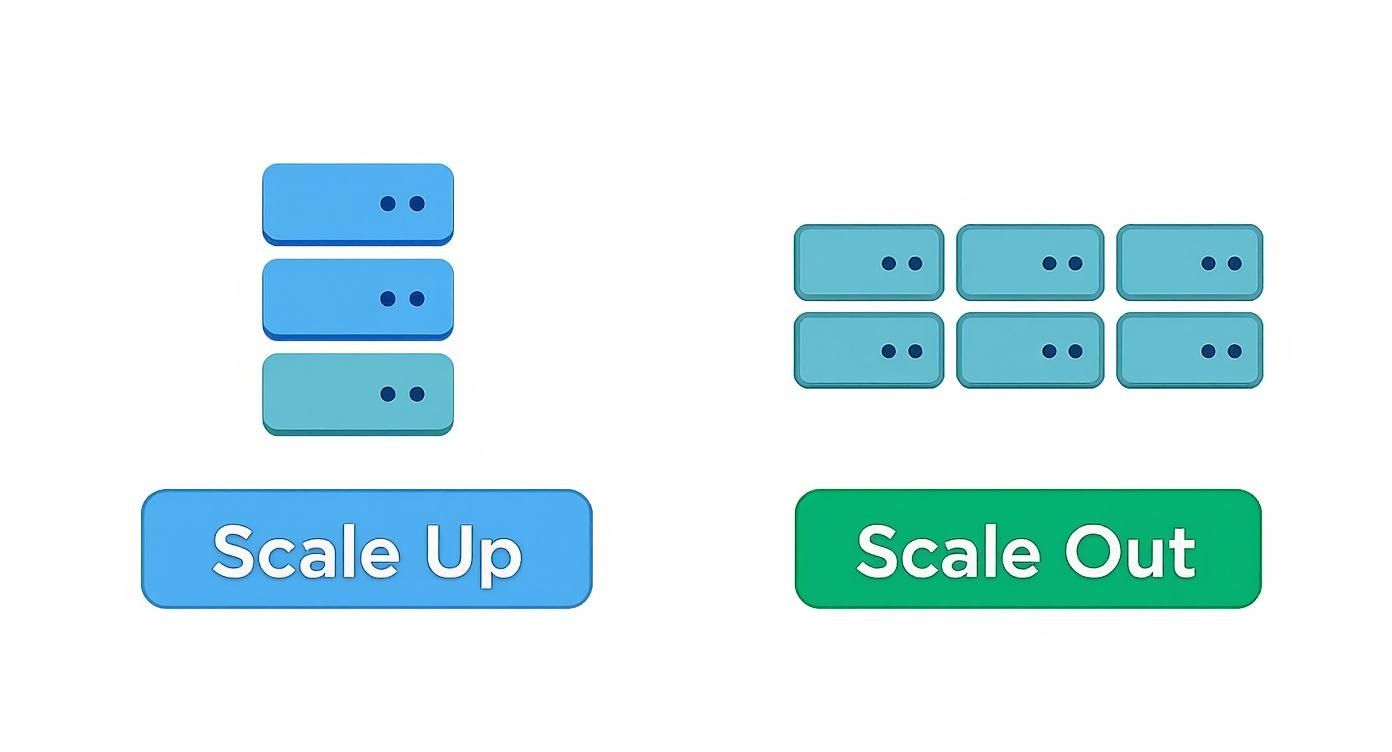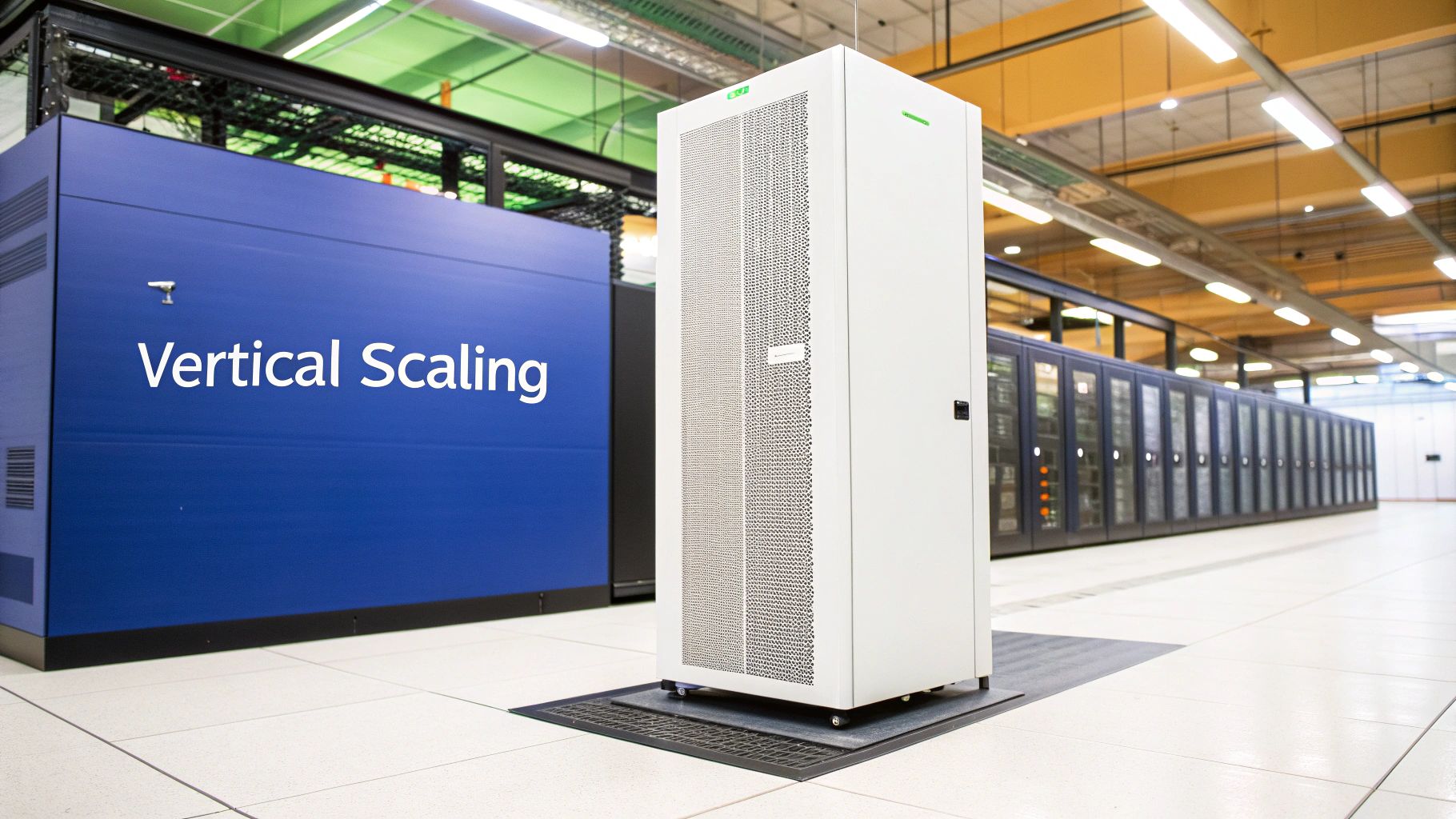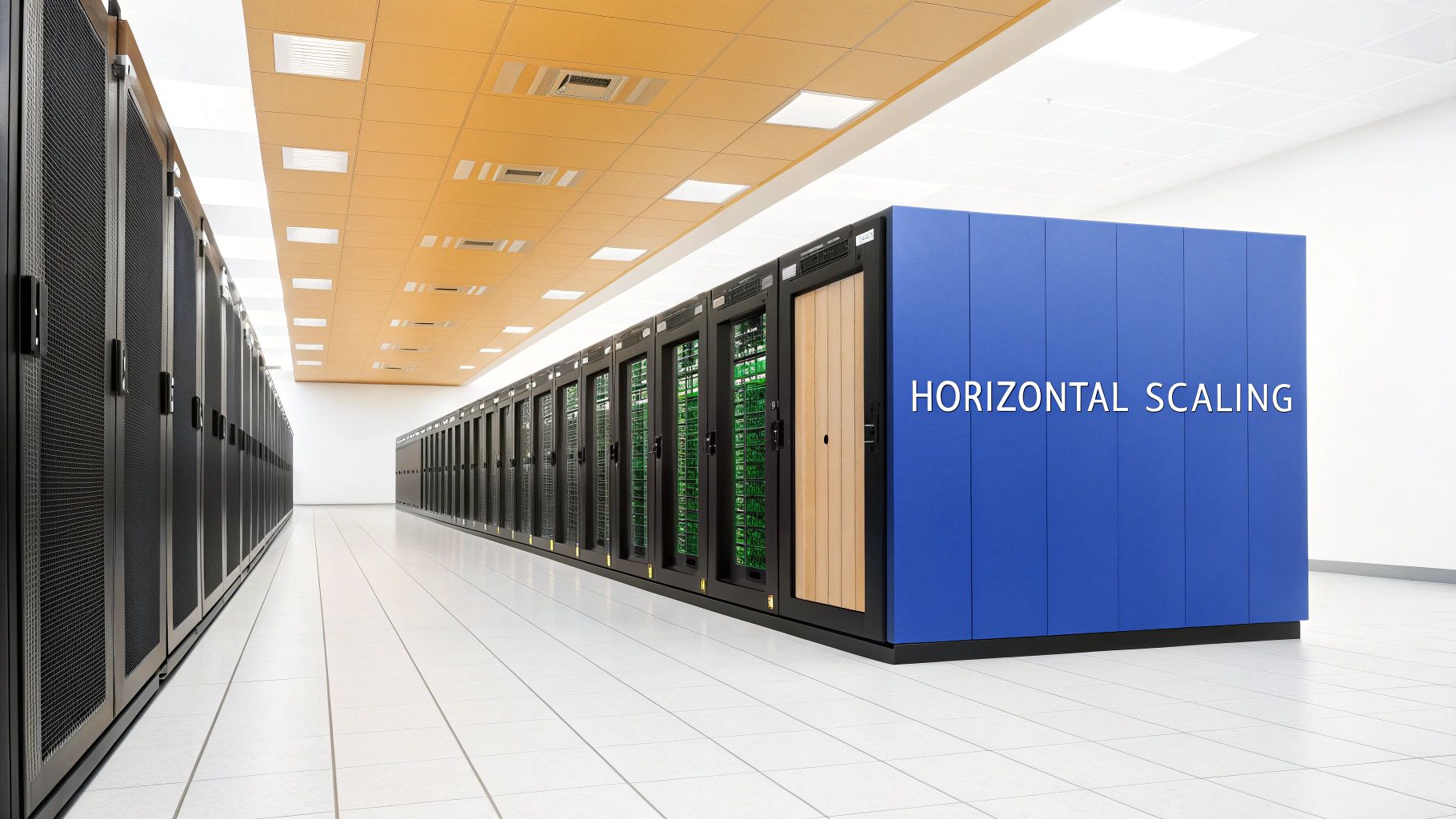Let's get one thing straight: the difference between horizontal and vertical scaling is simple. Think of it like this: vertical scaling is like upgrading your car's engine for more power. Horizontal scaling is like adding more cars to your delivery fleet to handle more packages.
What Are Your Core Scaling Options?
When your app starts getting popular and traffic picks up, your infrastructure has to keep pace. This is scalability: making sure your service stays fast and reliable no matter how many users show up. The two classic ways to handle this growth are vertical and horizontal scaling. Each has its own playbook and consequences for your system's future.
Choosing the right path is a huge decision in your system's design. It's going to directly hit your performance, your cloud bill, and how easily you can handle the next big traffic spike. One approach is about beefing up what you already have; the other is about multiplying your resources.
A Head-to-Head Comparison
Before you can make a smart decision, you need to know exactly what you're getting into with each method. The engine vs. fleet analogy is a great starting point, but the devil is in the details.
Let's break down how they stack up against each other.
| Aspect | Vertical Scaling (Scaling Up) | Horizontal Scaling (Scaling Out) |
|---|---|---|
| How It Works | Adds more power, like CPU, RAM, or storage, to a single server. | Adds more servers (nodes) to a resource pool to share the load. |
| Real-World Analogy | Upgrading your laptop with a faster processor and more memory. | Building a computer cluster by linking multiple machines together. |
| Implementation | Usually simpler to get started. The application logic doesn't have to change. | More complex. You'll need things like load balancers and a distributed setup. |
| The Catch | You're limited by the max power a single machine can handle. There's a hard ceiling. | Nearly limitless. Your only constraints are your budget and management tools. |
This isn't just about handling today's traffic. It's about architecting a system that can gracefully handle the unpredictable demands of tomorrow.
Ultimately, vertical scaling is a straightforward way to get a performance boost, but you will eventually hit a wall. Horizontal scaling, on the other hand, gives you a path to almost infinite growth, but it forces you to deal with more architectural complexity right from the start.
A Detailed Comparison of Scaling Methods
Once you get past the basic definitions, the real choice between horizontal and vertical scaling comes down to the details. This isn't just about adding more power; it's an architectural decision that impacts everything from system resilience and performance to your monthly cloud bill. Let's break down the key differences to see where each approach truly shines.
Fault Tolerance and Resilience
When it comes to keeping your application online, the two methods couldn't be more different. Horizontal scaling is inherently resilient. Because your workload is spread across a fleet of independent servers, the failure of one machine doesn't spell disaster. The others simply pick up the slack, and with a good load balancer, your users might not even notice a hiccup.
Vertical scaling is the exact opposite. By concentrating all your resources into a single, super-powered server, you’ve created a single point of failure. If that one machine goes down, whether from a hardware issue or a software glitch, your entire application goes offline with it. This makes it a much riskier bet for any service where uptime is critical.
This side-by-side comparison visualizes the core difference between scaling up with a single server and scaling out with multiple servers.

As the infographic shows, it's a choice between one powerful unit or a distributed team of many.
Performance Limits and Latency
Performance is another area full of trade-offs. Vertical scaling can deliver incredibly low latency for certain tasks. Since everything happens on one machine, there’s no network lag between components. Think of applications like high-frequency trading platforms, where every microsecond counts. That's where vertical scaling excels.
But there's a catch: you eventually hit a wall. You can only cram so much CPU and RAM into a single server before you reach the absolute physical limit of what's possible (or affordable).
Horizontal scaling, on the other hand, is built for practically infinite growth. Its strength lies in handling massive numbers of concurrent users by spreading the load. Yes, there's a tiny bit of network latency as the nodes talk to each other, but for most web-scale applications, the ability to serve millions of users at once more than makes up for it.
The core trade-off is clear: Vertical scaling offers superior single-node speed with a definite performance cap, while horizontal scaling provides near-infinite capacity at the cost of slight network latency.
Implementation Complexity and Data Consistency
Getting each strategy up and running presents its own set of challenges. Vertical scaling is often the simpler path, especially for legacy applications. It might mean some scheduled downtime while you upgrade the hardware, but you usually don't have to rewrite your application's code.
Horizontal scaling, or "scaling out," is more involved. You're not just adding servers; you're building a distributed system that needs load balancing, service discovery, and careful network management. While this can be more cost-effective at scale, real-world data shows the orchestration overhead can add 10–20% to your operational costs. You can find more insights on horizontal vs vertical scaling at Clarifai.
Data consistency is also a major hurdle in scaled-out systems. Keeping data synchronized across multiple nodes is a complex problem to solve. In a vertically scaled world, it's a non-issue: there’s only one source of truth on that single machine.
To make the differences even clearer, here's a direct feature-by-feature breakdown.
Horizontal vs Vertical Scaling Feature Breakdown
| Attribute | Vertical Scaling (Scaling Up) | Horizontal Scaling (Scaling Out) |
|---|---|---|
| Resilience | Low (Single point of failure) | High (Fault-tolerant by design) |
| Scalability Limit | Hard physical limit per server | Virtually limitless with more nodes |
| Performance | Very low latency, high single-node speed | High throughput for concurrent users |
| Implementation | Simpler, often no code changes | More complex, requires architectural changes |
| Cost Structure | High cost for premium hardware | Lower cost per node, pay-as-you-grow |
| Data Consistency | Simple to maintain (single source) | Complex to manage across nodes |
| Ideal Use Case | Databases, stateful applications | Web servers, microservices, stateless apps |
Ultimately, choosing between these two isn't just a technical exercise. It’s a strategic decision that shapes your system's future. One path prioritizes simplicity and raw speed, while the other champions resilience and massive scale. A careful look at your application's specific needs is the only way to make the right call.
Analyzing the Economic Impact of Scaling
Your scaling strategy's financial impact is just as critical as the technical side of things. When you get down to comparing horizontal vs. vertical scaling, the total cost goes way beyond just the server price. It’s a decision that hits your budget now and in the long run.
At first glance, vertical scaling looks like it has a higher barrier to entry. "Scaling up" means buying premium, enterprise-grade hardware. The most powerful CPUs, biggest RAM modules, and fastest storage don't come cheap, which means a big upfront capital investment.
On top of that, a lot of enterprise software licenses are priced per core. As you scale up by adding more CPU cores to one big machine, your software licensing fees can shoot up right alongside, tying performance directly to recurring operational costs.
The Hidden Costs of Scaling Out
Horizontal scaling flips this model around. It starts with a lower entry cost because it relies on lots of smaller, commodity servers. Individually, these are much cheaper than a single high-end machine. This pay-as-you-grow approach can feel a lot more budget-friendly at the start.
But scaling out brings its own set of expenses that are easy to overlook. The complexity of running a distributed system creates new operational overhead. These "hidden" costs are absolutely crucial to factor in if you want an accurate financial picture.
The true cost of horizontal scaling isn't just in the servers. It's in the sophisticated ecosystem you need to build to make them all work together seamlessly. Ignore that, and you're in for some nasty budget surprises.
For example, a horizontally scaled setup is completely dependent on good load balancing. That means investing in either hefty load-balancing hardware or advanced cloud services to spread the traffic intelligently. Your network infrastructure also has to be top-notch to handle all the chatter between nodes without becoming a bottleneck.
Calculating the Total Cost of Ownership
Ultimately, the best financial move depends on your growth plans and operational muscle. The trick is to look past the server price tags.
A complete financial breakdown should include:
- Hardware Costs: Premium servers for vertical scaling versus a fleet of commodity servers for horizontal scaling.
- Software Licensing: Per-core licensing models can make vertical scaling surprisingly expensive.
- Operational Overhead: The cost of load balancers, networking gear, and monitoring tools needed for distributed systems.
- Talent and Expertise: Managing a complex, scaled-out environment demands specialized engineering talent, which comes at a premium.
A balanced financial analysis is essential. For many businesses, solid cloud cost optimisation strategies can help soften the blow, no matter which scaling method you choose. Understanding these financial nuances is key to building an infrastructure that’s not just powerful, but also economically sustainable.
When to Choose Vertical Scaling

While scaling out often gets all the attention in modern cloud discussions, scaling up is far from obsolete. Choosing vertical scaling can be a powerful and pragmatic move, especially when raw, single-machine performance and simplicity are the name of the game.
For startups and smaller projects, it's often the most logical first step. You can add more power, more CPU, more RAM, without having to completely re-engineer your application. It’s a straightforward way to delay the jump to a complex distributed system until you absolutely need it.
Applications Demanding Low Latency
When every microsecond is critical, vertical scaling is the clear winner. All the processing happens on a single machine, which means communication overhead between components is practically zero. This makes it the go-to choice for any system where network latency is the enemy.
Think about these high-stakes scenarios:
- High-Frequency Trading Platforms: Financial systems executing thousands of trades a second depend on the instant response that only one beast of a server can deliver.
- Online Transaction Processing (OLTP) Databases: Think of your bank's transaction system or an e-commerce checkout. These systems need immediate processing to keep data consistent and users happy.
In these situations, the sheer speed you get from keeping everything local is far more valuable than the benefits of spreading the load. When your business model hinges on ultra-low latency, the debate over scaling up vs. scaling out looks very different.
Monolithic and Stateful Systems
Vertical scaling is also a natural ally for monolithic applications and stateful systems, the kinds of software that are tricky, or even impossible, to break apart. Traditional relational databases, for instance, almost always run better on a single, beefy machine.
Choosing to scale up is often the path of least resistance for stateful applications. It avoids the immense challenge of managing data consistency and replication across a distributed cluster, simplifying both deployment and maintenance.
Trying to manage a stateful application, where the system has to remember what happened in previous interactions, gets exponentially harder in a horizontal setup. You suddenly have to worry about session persistence and making sure every server sees the exact same data at the same time. Vertical scaling neatly sidesteps all of that by keeping the state in one place, making it a reliable pick for applications that weren't born in a distributed world.
When to Choose Horizontal Scaling

Horizontal scaling, or "scaling out," is the secret sauce behind the world’s biggest and most bulletproof applications. It's the go-to strategy for any modern, cloud-native system that needs to handle massive growth and stay online, moving well past what a single powerful machine can offer.
This approach really comes into its own when you’re facing unpredictable or explosive traffic. Think about an e-commerce site on Black Friday or a streaming platform during a live global event. In these moments, being able to spin up new servers on the fly isn't just a nice-to-have; it's a matter of survival.
Building for Resilience and High Availability
The true beauty of horizontal scaling lies in its built-in fault tolerance. When you spread the workload across a fleet of independent servers, you get rid of any single point of failure. If one server crashes, the others just pick up the slack, and your users never even notice.
This distributed model is the foundation of high availability. A few key pieces make this work:
- Stateless Web Servers: When your application doesn't store user session data on the server itself, you can replicate it endlessly. Any server can handle any request, which makes adding more capacity incredibly simple.
- Microservices: By breaking down a monolithic application into small, independent services, you can scale each part on its own. This means you can throw more resources just at the components that are under heavy load.
- Effective Load Balancing: This is the critical traffic cop that intelligently directs incoming requests across all your servers. For a closer look, our guide on load balancing in AWS is a must-read for anyone serious about scaling out.
This type of architecture ensures that one small failure doesn’t cascade into a full system meltdown, a crucial difference when you're weighing horizontal vs. vertical scaling.
Architecting for Limitless Growth
Horizontal scaling has virtually no ceiling. You aren’t limited by the physical constraints of a single server; you can just keep adding more machines to meet demand. It's the core principle that allows hyperscalers like Google and Netflix to operate at their mind-boggling scale.
Scaling out is more than a technical tactic; it’s an architectural philosophy. It works from the assumption that failures will happen and builds a system that can absorb them gracefully while growing to meet any demand.
Ultimately, choosing to scale horizontally is a commitment to building a dynamic, resilient, and future-proof system. It's the clear winner for any application where downtime is not an option and growth is expected to be significant and unpredictable.
Here's the rewritten section, designed to sound like it was written by an experienced human expert, following all your requirements.
Implementing a Hybrid Scaling Strategy
The whole debate over horizontal vs. vertical scaling often misses a key point for modern cloud infrastructure: it’s rarely an either/or choice. The most effective, resilient systems almost always blend both approaches into a powerful hybrid strategy, letting you fine-tune your architecture for both cost efficiency and raw power.
This means applying the right scaling method to the right component. For example, stateless services like web servers or API gateways are perfect candidates for horizontal scaling. You can easily add or remove instances to match traffic spikes and lulls, ensuring high availability without paying for idle resources.
Combining Scaling for Optimal Results
At the same time, some stateful components, like a primary database or a heavy-duty data processing engine, might benefit more from vertical scaling. Beefing up the CPU and RAM on a single, powerful node can deliver the low latency and transactional consistency these workloads demand, helping you sidestep the complexities of distributed data management. This dual approach creates a much more balanced and robust architecture.
The rise of hybrid strategies simply reflects the complex needs of today's global businesses. Look at Netflix. They horizontally scale their massive microservices architecture to handle millions of concurrent streams. Yet, their critical data processing and machine learning tasks often run on vertically scaled nodes to get maximum throughput. In fact, over 40% of Fortune 500 companies now use some form of hybrid scaling, and some businesses report cutting their cloud spend by 18% after making the switch. You can find more insights on hybrid cloud cost savings at CloudZero.
A hybrid model lets you treat your infrastructure like a toolkit, not a dogma. You use the best tool for each specific job: scaling out where you need elasticity and scaling up where you need concentrated power.
Modern orchestration tools make this sophisticated approach practical. In a Kubernetes environment, for instance, you can use a Horizontal Pod Autoscaler (HPA) to scale out your application pods and a Vertical Pod Autoscaler (VPA) to scale up the resources for specific, demanding ones. Managing this effectively takes expertise, which is where specialized cloud computing management services become invaluable. By combining these tools, you can build a truly dynamic and efficient system.
Common Scaling Questions Answered
Even when you get the difference between horizontal and vertical scaling, a few practical questions always seem to pop up. Let's tackle some of the most common ones so you can apply these ideas with confidence.
Can You Switch Scaling Methods Later?
Yes, but it’s rarely a simple flip of a switch. Migrating an application built for vertical scaling, think of a classic monolith, to a distributed architecture ready for horizontal scaling is a major project.
This isn't just a tweak; it often requires a ground-up architectural redesign. It’s far more painful than planning for a distributed setup from the very beginning.
How Does Auto-Scaling Work?
Auto-scaling can actually use both methods. The one you hear about most is horizontal, where new servers are automatically added or removed based on traffic spikes. It’s the classic "add more machines" approach.
However, vertical auto-scaling is also a thing. This is where the CPU and RAM of existing servers are adjusted up or down on the fly. Modern platforms like Kubernetes are sophisticated enough to handle both, giving you dynamic ways to manage your resources.
The best approach is rarely about choosing one method forever. It’s about knowing when and how to transition or combine them as your application evolves.
Is One Scaling Method Better for Databases?
This one truly depends on the database technology you're using. Traditional SQL databases are often much simpler to scale vertically. Beefing up a single server avoids the massive headaches of keeping data consistent across multiple nodes.
On the other hand, many NoSQL databases were born for horizontal scaling. They’re designed from day one to distribute data across huge clusters of servers, allowing them to manage enormous datasets and insane throughput levels.
Ready to stop paying for idle cloud resources? CLOUD TOGGLE makes it easy to automatically power off servers on a schedule, cutting your cloud spend without complex configurations. Start your free 30-day trial and see how much you can save.




